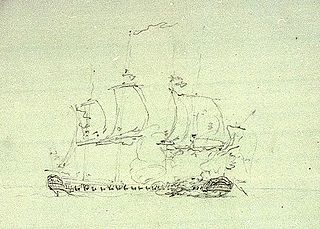 W
WThe Action of 18 June 1793 was the first decisive and one of the most celebrated encounters between British and French frigates during the French Revolutionary Wars. The action occurred off Start Point in Devon, when the British frigate HMS Nymphe encountered and chased the French frigate Cléopâtre. During the previous month, Cléopâtre and another frigate, Sémillante, had been successfully raiding British merchant shipping in the English Channel and Eastern Atlantic from their base at Cherbourg. In response, the British frigates Nymphe and HMS Venus had been ordered to intercept and defeat the French frigates and on 27 May Venus and Sémillante fought an inconclusive engagement off Cape Finisterre.
 W
WThe Action of 20 October 1793 was a minor naval engagement of the French Revolutionary Wars fought off Cape Barfleur on the French coast of the English Channel. The early months of the war, which had begun in February, had seen a number of French frigates raiding British merchant shipping in the Channel, and HMS Crescent under Captain James Saumarez was deployed to watch the port of Cherbourg with the aim of disrupting the operations of the French frigates Réunion and Sémillante that were based in the harbour. On 20 October, Saumarez was waiting off Cape Barfleur for French movement when his lookout sighted Réunion and the cutter Espérance approaching from open water.
 W
WThe Action of 22 October 1793 was a minor naval engagement fought in the Mediterranean Sea during the War of the First Coalition, early in the French Revolutionary Wars. During the engagement a lone British Royal Navy ship of the line, the 64-gun HMS Agamemnon, attacked the French Navy large frigate Melpomène, part of a larger squadron, off the coast of Sardinia. Although Agamemnon chased Melpomène some distance through the night and inflicted significant damage, the French frigate was able to escape following the arrival of the rest of its squadron under Commodore Jean-Baptiste Perrée. The French ships later anchored in Corsican harbours to land reinforcements for the French garrison on the island, where the population was in open revolt.
 W
WThe Action of 24 October 1793 was a minor naval engagement during the first year of the French Revolutionary Wars. While cruising in the Northern Bay of Biscay, the British Royal Navy frigate HMS Thames, under Captain James Cotes, encountered the much larger French frigate Uranie, under Captain Jean-François Tartu. The ships engaged, with each suffering severe damage until they separated after nearly four hours of continual combat. Cotes ordered his crew to make hasty repairs, intending to resume the battle, but Uranie's crew, with their captain dead, slipped away while Thames was unable to manoeuvre. At 16:00, with repairs on Thames ongoing, a French squadron of three frigates and a brig, under Captain Zacharie Allemand, arrived, firing on Thames as they approached. Outnumbered, Cotes surrendered his ship to Allemand, who commended Cotes on his resistance to the far larger Uranie.
 W
WThe Action of 31 July 1793 was an inconclusive engagement between a British Royal Navy frigate and French frigate off the New Jersey coastline in the first year of the French Revolutionary Wars. The British captain, George Courtenay of HMS Boston, had arrived off New York City on 28 May and deliberately disguised his ship as a French vessel, fooling a French officer into coming aboard and making him a prisoner of war. Courtenay then sent a message into New York, where he knew a French frigate lay at anchor, challenging the French captain to battle within the next three days. The challenge was accepted and widely disseminated throughout the city, so that when Captain Jean-Baptiste-François Bompart of Embuscade sailed out to meet Courtenay on the morning of 31 July, the shore was crowded with thousands of sightseers.
 W
WThe Siege of Angers was a siege of the French town of Angers on 3 December 1793 in the War in the Vendée.
 W
WThe Battle of Avesnes-le-Sec was a military action during the Flanders Campaign of the French Revolutionary Wars, between French forces under General Nicolas Declaye, and Imperial Austrian forces under Prince of Hohenlohe-Kirchberg. The Austrian cavalrymen made an overwhelming charge against the French and severely defeated them.
 W
WThe Battle of Arlon saw a French Republican force under the command of Amable Henri Delaage face the Habsburgs's force led by Gottfried von Schröder. The French were victorious though they suffered higher casualties than the Austrians. The action was fought during the War of the First Coalition, part of the larger French Revolutionary Wars. Arlon is located in Belgium, a distance of 30 kilometres (19 mi) west of Luxembourg city.
 W
WOber-Flörsheim is an Ortsgemeinde – a municipality belonging to a Verbandsgemeinde, a kind of collective municipality – in the Alzey-Worms district in Rhineland-Palatinate, Germany.
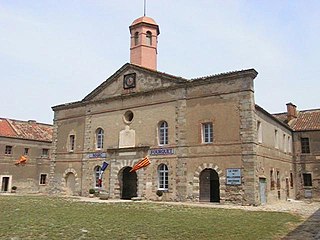 W
WThe Siege of Bellegarde commenced on 23 May 1793 and ended on 24 June 1793 when Colonel Boisbrulé's French garrison surrendered the Fort de Bellegarde to a Spanish army under the command of Antonio Ricardos. The capture of the fort gave Spain control of an important road through the Pyrenees. The siege took place during the War of the Pyrenees, part of the French Revolutionary Wars. Fort de Bellegarde is on a height overlooking the border town of Le Perthus, which lies on the modern A9 autoroute and Autovía A-7.
 W
WThe Siege of Breda took place from 21 to 27 February 1793 in the course of the Flanders Campaign during the War of the First Coalition.
 W
WThe Childers Incident of 2 January 1793 marked the opening shots between British and French forces during the French Revolutionary Wars, the first phase of a 23-year-long war between the two countries. Following the French Revolution of 1789, diplomatic relations between the Kingdom of Great Britain and the French Republic had steadily deteriorated and France was in political and social turmoil. One of the strongest hotbeds of republican activity was the principal Atlantic naval base of the French Navy at Brest in Brittany, the scene of a significant mutiny in 1790.
 W
WThe Second Battle of Cholet was fought on 17 October 1793 during the French Revolutionary Wars, between French Republican forces under General Jean Léchelle and French Royalist Forces under Maurice d'Elbée. The battle was fought in the town of Cholet in the Maine-et-Loire department of France, and resulted in a Republican victory. D’Elbée was wounded and captured; he was later executed by Republican troops in Noirmoutier. The Royalist insurgent, Charles Melchior Artus de Bonchamps, was fatally wounded in the battle.
 W
WThe Battle of Collioure saw troops from the Kingdom of Spain attack a Republican French division during the War of the Pyrenees. The Spanish troops led by Gregorio García de la Cuesta were completely successful in ousting the French under Louis Pierre François Delattre from Collioure, Fort Saint-Elme and Port-Vendres. The contending sides were the Spanish Army of Catalonia commanded by Antonio Ricardos and the French Army of the Eastern Pyrenees led by François Amédée Doppet and Eustache Charles d'Aoust. In September 1793, the French successfully defended Perpignan from Spanish attack but December saw a series of French defeats. One of the French representatives on mission, Claude Dominique Côme Fabre was killed during the fighting at Collioure. Aoust and Delattre were arrested, condemned and executed by guillotine for the disaster.
 W
WThe Siege of Condé saw a force made up of Habsburg Austrians and French Royalists commanded by Duke Ferdinand Frederick Augustus of Württemberg lay siege to a Republican French garrison led by Jean Nestor de Chancel. After a blockade lasting about three months the French surrendered the fortress. The operation took place during the War of the First Coalition, part of a larger conflict known as the French Revolutionary Wars. Condé-sur-l'Escaut, France is located near the Belgium border about 14 kilometres (9 mi) northeast of Valenciennes.
 W
WThe East Indies theatre of the French Revolutionary Wars was a series of campaigns related to the major European conflict known as the French Revolutionary Wars, fought between 1793 and 1801 between the new French Republic and its allies and a shifting alliance of rival powers. Although the Indian Ocean was separated by vast distance from the principal theatre of the conflict in Western Europe, it played a significant role due to the economic importance of the region to Great Britain, France's most constant opponent, of its colonies in India and the Far Eastern trade.
 W
WThe Battle of Epierre was part of a larger War of the First Coalition campaign that pitted a Republican French army led by François Christophe de Kellermann against a numerically stronger Kingdom of Sardinia-Piedmont army commanded by the Prince Maurizio, Duke of Montferrat. Under the overall leadership of the Austrian commander in chief Joseph Nikolaus De Vins, Montferrat launched an offensive in mid-August 1793 to recapture the Duchy of Savoy from the French. Because the French were preoccupied with the Siege of Lyon, the Piedmontese recovered most of the Maurienne and Tarentaise Valleys, but they were stopped just short of Albertville and the reconquest of Savoy. In September, Kellermann launched a counteroffensive in which he adroitly switched his troops between valleys in order to drive back the Piedmontese. At Épierre, the French under Jean-Denis Le Doyen defeated the Marquis of Cordon in a local action. By 8 October the Piedmontese abandoned all their gains and withdrew to the crests of the Graian Alps. In spite of his victory, the suspicious politicians in Paris put Kellermann in arrest and he was imprisoned until November 1794.
 W
WThe Machecoul massacre is one of the first events of the War in the Vendée, a revolt against mass conscription and the civil constitution of the clergy. The first massacre took place on 11 March 1793, in the provincial city of Machecoul, in the district of the lower Loire. The city was a thriving center of grain trade; most of the victims were administrators, merchants and citizens of the city.
 W
WThe Siege of Fort-Louis saw a force composed of Habsburg Austrians, Hessians and Bavarians led by Franz von Lauer lay siege to Fort-Louis which was held by a Republican French garrison under Michel Durand. The French capitulated after a defense lasting exactly one month. The siege occurred during the War of the First Coalition, part of the French Revolutionary Wars. In 1793 the fortress was sited on an island in the Rhine River, but today Fort-Louis is a village in the Bas-Rhin department in France.
 W
WThe battle of Fougères was a battle on 3 November 1793 at Fougères, during the Virée de Galerne. It was a Vendéen victory.
 W
WThe Raid on Genoa was a minor naval engagement fought in the harbour of the Italian city of Genoa during the first year of the French Revolutionary Wars. French Republican forces in the Mediterranean, under pressure from Austrian and Spanish armies, Royalist uprisings and British blockade had suffered the loss of their principal naval base and the fleet stationed there when British forces under Lord Hood seized Toulon at the invitation of the city's Royalist faction. The survivors of the French fleet were scattered across the Mediterranean, several sheltering in neutral Italian harbours, including the frigates Modeste at Genoa and Impérieuse at Leghorn.
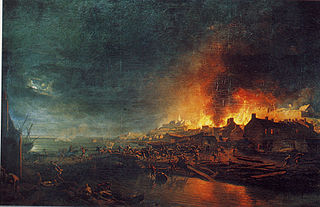 W
WThe Siege of Granville occurred at Granville, Manche on 14 November 1793. It faced 5,000 Republicans besieged by Vendéen forces during the Virée de Galerne. The battle ended with a Republican victory.
 W
WThe Battle of Hondschoote took place during the Flanders Campaign of the Campaign of 1793 in the French Revolutionary Wars. It was fought during operations surrounding the Siege of Dunkirk between 6 and 8 September 1793 at Hondschoote, Nord, France, and resulted in a French victory under General Jean Nicolas Houchard and General Jean-Baptiste Jourdan against the command of Marshal Freytag, part of the Anglo-Hanoverian corps of the Duke of York.
 W
WThe battle of La Tremblaye took place near Cholet during the war in the Vendée, and was a Republican victory over the Vendéens.
 W
WThe battle of Laval took place on 22 October 1793, during the war in the Vendée and saw Vendéen victory over republican troops. This is the first major battle of a particular episode of the war called the Virée de Galerne.
 W
WThe Battle of Le Mans was a combat in the Virée de Galerne, an operation during the War in the Vendée. It resulted in the rout of the Vendéen forces by Republican troops.
 W
WThe Siege of Le Quesnoy saw a force made up of Habsburg Austrians and French Royalists led by François Sébastien Charles Joseph de Croix, Count of Clerfayt lay siege to a Republican French garrison commanded by François Goullus. After two and a half week siege, the French capitulated after suffering heavy losses. The War of the First Coalition operation was fought at Le Quesnoy, located near the border with Belgium about 27 kilometres (17 mi) west of Maubeuge.
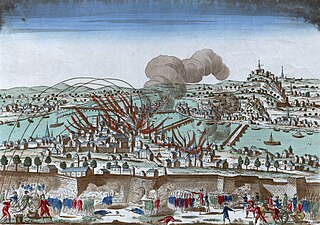 W
WThe Siege of Lyon occurred on 9 August to 9 October 1793 when French Republican forces laid siege and captured the city of Lyon, which was the centre of a revolt against the French government during the War of the First Coalition.
 W
WThe Siege of Maastricht was a failed siege of the city of Maastricht by the forces of the French First Republic from 6 February to 2 March 1793, marking the final action of the 1793 campaign of the War of the First Coalition. The city was successfully defended by the Dutch garrison with the assistance of a small band of French Royalists.
 W
WIn the Siege of Mainz, from 14 April to 23 July 1793, a coalition of Prussia, Austria, and other German states led by the Holy Roman Empire besieged and captured Mainz from revolutionary French forces. The allies, especially the Prussians, first tried negotiations, but this failed, and the bombardment of the city began on the night of 17 June.
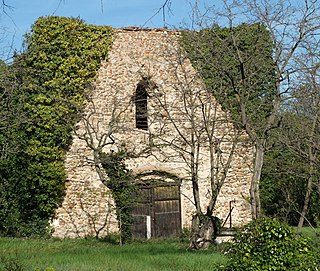 W
WThe Battle of Mas Deu or Battle of Mas d'Eu on 19 May 1793 saw the French Revolutionary Army of the Eastern Pyrenees under Louis-Charles de Flers fighting Bourbon Spain's army of Catalonia led by Antonio Ricardos.
 W
WThe Mediterranean campaign of 1793–1796 was a major theater of conflict in the early years of the French Revolutionary Wars. Fought during the War of the First Coalition, the campaign was primarily contested in the Western Mediterranean between the French Navy's Mediterranean Fleet, based at Toulon in Southern France, and the British Royal Navy's Mediterranean Fleet, supported by the Spanish Navy and the smaller navies of several Italian states. Major fighting was concentrated in the Ligurian Sea, and focused on British maintenance of and French resistance to a British close blockade of the French Mediterranean coast. Additional conflict spread along Mediterranean trade routes, contested by individual warships and small squadrons.
 W
WThe Battle of Wervik, or of Wervik and Menin was fought on 12 and 13 September 1793 between 30,000 men of the French Army of the North commanded by Jean Nicolas Houchard, and 13,000 Coalition troops: the veldleger of the Dutch States Army, commanded by the William, Hereditary Prince of Orange and his brother Prince Frederick of Orange-Nassau, and a few squadrons of Austrian cavalry under Pál Kray, seconded by Johann Peter Beaulieu. The great superiority in numbers being on the French side the battle ended in a victory for France, with the Dutch army suffering heavy losses. Among the casualties was Prince Frederick, who was wounded in the shoulder at Wervik, an injury from which he never fully recovered. The combat occurred during the Flanders Campaign of the War of the First Coalition. Menen is a city in Belgium located on the French border about 100 kilometres (62 mi) west of Brussels.
 W
WThe Battle of Neerwinden saw a Republican French army led by Charles François Dumouriez attack a Coalition army commanded by Prince Josias of Saxe-Coburg-Saalfeld. The Coalition army of the Habsburg Monarchy together with a small contingent of allied Dutch Republic troops repulsed all French assaults after bitter fighting and Dumouriez conceded defeat, withdrawing from the field. The French position in the Austrian Netherlands swiftly collapsed, ending the threat to the Dutch Republic and allowing Austria to regain control of her lost province. The War of the First Coalition engagement was fought at Neerwinden, located 57 kilometres (35 mi) east of Brussels in present-day Belgium.
 W
WThe Newfoundland expedition was a series of fleet manoeuvres and amphibious landings in the coasts of Newfoundland, Labrador and Saint Pierre and Miquelon carried out by the combined French and Spanish fleets during the French Revolutionary Wars. This expedition, composed of seven ships of the line and three frigates under the orders of Rear-Admiral Richery sailed from Cadiz in August 1796 accompanied by a much stronger Spanish squadron, commanded by General Solano, which had the aim of escorting it to the coast of Newfoundland.
 W
WThe First Battle of Noirmoutier took place on 12 October 1793 as part of the war in the Vendée. The Vendéens under François de Charette were victorious over the republican troops stationed there.
 W
WThe Battle of Perpignan or Battle of Niel (fr:Bataille de Perpignan) on 17 July 1793 saw the French Army of the Eastern Pyrenees led by Louis-Charles de Flers defending against an offensive by the Spanish Army of Catalonia commanded by Antonio Ricardos. The French turned back the Spanish attacks and forced their opponents to pull back. Perpignan is now the capital of Pyrénées Orientales department, but in 1793 was the chief city of Rousillon province. The action was fought during the War of the Pyrenees, part of the War of the First Coalition.
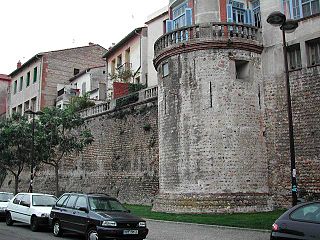 W
WThe Battle of Peyrestortes saw soldiers of the First French Republic fighting troops of the Kingdom of Spain during the War of the Pyrenees. Forces from the French Army of the Eastern Pyrenees, temporarily commanded by Eustache Charles d'Aoust and Jacques Gilles Henri Goguet, defeated two divisions of the Army of Catalonia led by Juan de Courten and Jerónimo Girón-Moctezuma, Marquis de las Amarillas. This Spanish setback in an attempt to capture Perpignan marked the high point of their invasion of Roussillon.
 W
WFor other sieges with this name, see Siege of Pondicherry (disambiguation)
 W
WThe Battle of Pont-Barré saw Royalist Vendeans under Pierre Duhoux and Dominique Piron de La Varenne fighting a Republican French column under Charles François Duhoux near Saint-Lambert-du-Lattay. Duhoux's Republican column advanced southwest from Angers and encountered Vendean defenders led by his nephew Pierre at the bridge over the Layon River. The rebels held their ground until reinforcements under Piron La Varenne arrived and gained the upper hand. The Vendeans put the Republicans to flight, killing 1,362 soldiers and capturing all their artillery. The action was part of a Republican strategy of invading the Vendée from several different directions. The rebels concentrated against and defeated the encroaching columns one by one at Coron, Tiffauges, Pont-Barré, Montaigu and Saint-Fulgent.
 W
WThe Battle of Saint-Fulgent saw Royalist and Republican French forces clash at Saint-Fulgent during the War in the Vendée. The 11,000 Vendean rebels led by Henri de La Rochejaquelein defeated a 6,000-man Republican division commanded by Jean Quirin de Mieszkowski belonging to the Army of the Coasts of La Rochelle. Half of the Republican force was killed, wounded or captured while rebel losses were only one-tenth as high. In mid-September the Republican Army of the Coasts of La Rochelle led by Jean Antoine Rossignol advanced into the Vendée from the south and east while the Army of the Coasts of Brest and the Army of Mainz under Jean Baptiste Camille Canclaux advanced from the west. In a series of battles at Coron, Pont-Barré, Tiffauges, Montaigu and Saint-Fulgent, the Royalist rebels concentrated against and defeated each Republican column in turn.
 W
WThe First Battle of Saorgio saw a Republican French army commanded by Gaspard Jean-Baptiste Brunet attack the armies of the Kingdom of Sardinia-Piedmont and Habsburg Austria led by Joseph Nikolaus De Vins. The local Sardinian commander in the Maritime Alps was Charles-François Thaon, Count of Saint-André. Though the French were initially successful in this War of the First Coalition action, their main assaults against the strong defensive positions on the Massif de l'Authion and the Col de Raus failed with serious losses. Saorge is now located in France about 70 kilometres (43 mi) northeast of Nice, but in 1793 Saorgio belonged to Piedmont. In April 1794 the French seized the positions from the Austro-Sardinians in the Second Battle of Saorgio.
 W
WThe French expedition to Sardinia was a short military campaign fought in 1793 in the Mediterranean Sea in the first year of the War of the First Coalition, during the French Revolutionary Wars. The operation was the first offensive by the new French Republic in the Mediterranean during the conflict, and was directed at the island of Sardinia, part of the Kingdom of Sardinia. Sardinia was neutral at the time, but immediately joined the anti-French coalition. The operation was a total failure, with attacks directed at Cagliari in the south and La Maddalena in the north both ending in defeat.
 W
WThe Battle of Savenay took place on 23 December 1793, and marks the end of the Virée de Galerne operational phase of the first war in the Vendée after the French Revolution. A Republican force of approximately 18,000 decisively defeated the Armée Catholique et Royale force of 6,000 at Savenay.
 W
WThe Souliote War (1789–1793) was an armed conflict between Ali Pasha of Ioannina and a coalition of Souliotes and their Muslim allies. The war lasted between February 1789 and April 1793 and was fought in the context of the Russo-Turkish War (1787–1792) and local power struggles. The Souliotes achieved a defensive victory but failed to foment a big Christian insurrection as originally planned.
 W
WThe Battle of Thouars was a battle between Royalist and Republican French forces during the War in the Vendée. The Royalists or Vendeans led by Louis Marie de Lescure, Charles de Bonchamps and Henri de La Rochejaquelein seized the town of Thouars and compelled its Republican defenders under Pierre Quétineau to surrender.
 W
WThe battle of Torfou-Tiffauges was a battle on 19 September 1793 during the War in the Vendée. It pitted many Royalist military leaders against Republican troops under Jean-Baptiste Kléber and Canclaux.
 W
WThe Siege of Toulon was a military engagement that took place during the Federalist revolts of the French Revolutionary Wars. It was undertaken by Republican forces against Royalist rebels supported by Anglo-Spanish forces in the southern French city of Toulon. It was during this siege that young Napoleon Bonaparte first won fame and promotion when his plan, involving the capture of fortifications above the harbor, was credited with forcing the city to capitulate and the Anglo-Spanish fleet to withdraw.
 W
WThe fate of the French fleet at the Siege of Toulon marked one of the earliest significant operations by the British Royal Navy during the French Revolutionary Wars. In August 1793, five months after the National Convention declared war on Great Britain, thus drawing Britain into the ongoing War of the First Coalition, the government of the French Mediterranean city of Toulon rose up against the Republican national government in favour of the Royalist faction. Toulon was the principal French naval port on the Mediterranean and almost the entirety of the French Mediterranean Fleet was anchored in the harbour. After negotiations the British commander in the Mediterranean, Admiral Lord Hood, the city's Royalists seized control and British forces, alongside allies from Spain, Naples and Sardinia entered the city, seizing the fleet and preparing defences against the inevitable Republican counterattack.
 W
WThe Tripolitanian civil war was a conflict from 1793 to 1795 which occurred in what is today the country of Libya. Ali Benghul, an Ottoman officer, deposed Hamet Karamanli, the ruler of Tripolitania, who had ruled since the end of the corrupt and ineffective rule of Ali I in 1793. Hamet and his brother Yusuf returned to Tripoli with the aid of the Bey of Tunis and took control of the throne.
 W
WThe Battle of Truillas was fought on 22 September 1793 during the French Revolutionary War between the French Army of the Eastern Pyrenees led by Luc Siméon Auguste Dagobert and the Spanish Army of Catalonia under Antonio Ricardos. This attempt by the French to exploit their success in the Battle of Peyrestortes ended in a Spanish victory. Part of the War of the Pyrenees, the battle was fought near the village of Trouillas in the French department of Pyrénées Orientales, 12 km southwest of Perpignan.
 W
WThe Siege of Valenciennes took place between 13 June and 28 July 1793, during the Flanders Campaign of the War of the First Coalition. The French garrison under Jean Henri Becays Ferrand was blockaded by part of the army of Prince Josias of Saxe-Coburg-Saalfeld, commanded by the Prince Frederick, Duke of York and Albany. Valenciennes fell on 28 July, resulting in an Allied victory.
 W
WThe Battle of Vihiers was a battle between Royalist and Republican French forces at Vihiers during the War in the Vendée. After the Republican division under Jacques-Marie Pilote La Barolière advanced into the heart of the revolt area, it was attacked by the Vendeans under Dominique Piron de La Vienne and routed. The advance guard under Jacques-François Menou held its ground for a long time, but many Republican units from the main body quickly took to their heels. The Republican cavalry under Louis-Nicolas Davout covered the disorderly retreat. The Royalists suffered about 1,000 killed and wounded but inflicted 2,000 killed and wounded on their enemies as well as capturing 3,000 soldiers and 25 artillery pieces.
 W
WThe Virée de Galerne was a military operation of the War in the Vendée during the French Revolutionary Wars across Brittany and Normandy. It takes its name from French virée (turn) and Breton gwalarn.
 W
WThe Battle of Wattignies saw a Republican French army commanded by Jean-Baptiste Jourdan attack a Coalition army directed by Prince Josias of Saxe-Coburg-Saalfeld. After two days of combat Jourdan's troops compelled the Habsburg covering force led by François Sébastien Charles Joseph de Croix, Count of Clerfayt to withdraw. The War of the First Coalition victory allowed the French to raise the Siege of Maubeuge. At a time when failed generals were often executed or imprisoned, Jourdan had to endure interference from Lazare Carnot from the Committee of Public Safety. The village, renamed Wattignies-la-Victoire in honor of the important success, is located 9 kilometres (6 mi) southeast of Maubeuge.